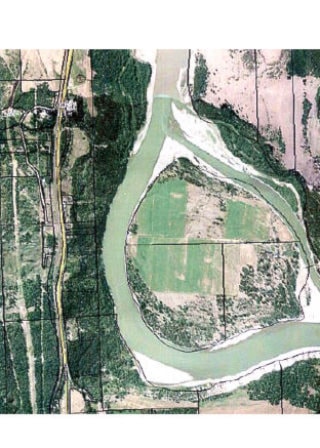Diamond Island is a unique place as it has a fascinating history and is the only island in the Fraser River that is large enough, 475 acres (192 ha) and high enough to be a permanent ranch, about midway between Quesnel and Williams Lake.
It was pre-empted by Lark Land and the access to it is Land Road, off West Fraser Road. James Land took up land, D.L.6145, south of the island on the west side of the river. He was buried, in 1934, in the old Quesnel cemetery.
Access from the Cariboo Waggon Road (Hwy. 97) was down what is now Alexandria Ferry Road North and Alexandria Ferry Road South, being a circular route that led to a reaction ferry across the Fraser opposite Land road, run by Charles Moffit.
At one time, the ferry broke loose while Christine Prestage was on it. It was caught down stream just in time.
Twenty-five years ago, the remains of the ferry scows were rotting on the east side after being pulled out, just above Diamond Island.
The island consists of D.L.4535 and D.L.4536. To get to it one forded the river from D.L. 6145 south of the ferry.
The land passed through several owners, with only a small acreage being cleared when Jack Lloyd bought it from an American company, Pemberton Securities in 1978. He cleared more land, built a house and barns. Then he logged the big fir timber. He was ideally situated for irrigation but only single phase power was available. One single phase, a 30 hp pump motor was the maximum. With three phase, 75 hp was possible.
Jack floated poles down to the island and ran a power line up to Highway 97 for the three phase. Many local ranchers joined him in campaigning for three phase power in the area. Jack had done hydro work previously. Eventually 200 acres (81 ha) was watered, feeding about 150 cows.
Summer range was needed and he got grazing rights to a huge area reaching west to Tzenzaicut Lake where plentiful wolves required sleeping in tents while on patrol. To move his stock to grass, he set up his own ferry carrying 20 head per trip after some years of swimming the cows across.
At one time he used an ex-army DUCK (a one ton GMC truck with a boat frame around it forming an amphibian; used during war to land on beaches or to cross rivers) with a 5,000 lb. capacity.
Jack loaded it way beyond that limit and had a hair-raising trip across the water sneaking over the sides.
Logging and saw milling were next with a woodlot and a mill partner. This led to silviculture contracting.
Illness forced him to convert to grain until he recovered, as that required less daily work.
Sandhill cranes, by the hundreds, on their way south, stopped to eat his barley. Later on, to get better access, he installed a causeway and later again a bridge, which brought problems of ice and government regulations.
Later he built his own bridge on land, much like Rudy Johnson, and slid it across on piles.
After years of hard work and solving unique problems, the Lloyds decided to sell while son Steve concentrated on his rodeo career and son Todd went into his own business.
The Lloyds are modern examples of how so many old time entrepreneurs met challenges head on and took extraordinary measures and their own money to achieve a worthwhile goal.
I am glad there are still people like them – the Cariboo is the better for them.
The Lloyds winter in Arizona where they can ride easily every day – a cowboy’s dream.
Andy Motherwell is an amateur historian and regular Observer contributor.
